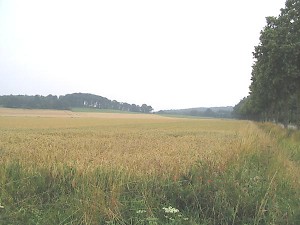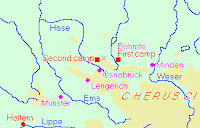Teutoburg Forest (6)
Battle in the Teutoburg Forest (Latin Saltus Teutoburgiensis): the defeat of the Roman commander Publius Quintilius Varus against the Germanic tribesmen of the Cheruscian leader Arminius in 9 CE. In this battle, three legions (XVII, XVIII, XIX) were annihilated.
The battle
Night After Day Two

Cassius Dio and Tacitus suggest that after the first attack, a substantial part of the Roman army was able to continue,
after securing a suitable place, so far as that was possible on a wooded mountain. Afterwards they either burned or abandoned most of their wagons and everything else that was not absolutely necessary to them.note
Dio states explicitly that this camp was on the site of the first attack. The words "after securing a suitable place" may suggest that it was in fact a small distance away from the Kalkriese narrows, because the Romans first had to disengage from their enemies. The suitable place on the "wooded mountain" may have been in the direction of modern Osnabrück, where the Romans would have had to cross the Wiehengebirge (or Wiehen hills). Tacitus also mentions this camp:
The partially fallen rampart and the shallow fosse suggested the inference that it was a shattered remnant of the army which had there taken up a position.note

The obvious place to cross the Wiehengebirge would be near modern Engter.
Day Three
Cassius Dio continues his story by stating that the Romans, after burning their wagons, advanced a little better on the third day,
and even reached open country, though they did not get off without loss. Upon setting out from there they plunged into the woods again, where they defended themselves against their assailants, but suffered their heaviest losses while doing so. For since they had to form their lines in a narrow space, in order that the cavalry and infantry together might run down the enemy, they collided frequently with one another and with the trees.note
If we are to believe Dio, and if we assume that the camp with the "fallen rampart" on the "suitable place" was somewhere near the Wiehengebirge, and if we accept that the remains of the army were marching to the Lippe, it is not unreasonable to think that the "open country" is the plain west of modern Osnabrück, which is situated between the Wiehengebirge in the north and, in the south, a mountain range that has in the sixteenth century erroneously been called Teutoburger Wald (Teutoburg Forest). If there is any reality behind the topical remark that the army "plunged into the woods again", the remains of the legions marched along the medieval road to Münster, and started to cross the Teutoburger Wald.
Dio refers to failing communication between cavalry and infantry, and it is interesting to see how Velleius Paterculus offers us something that must come close to the interpretation by a foot soldier:
Vala Numonius, lieutenant of Varus, [...] set a fearful example in that he left the infantry unprotected by the cavalry and in flight tried to reach the Rhine with his squadrons of horse. But fortune avenged his act, for he did not survive those whom he had abandoned, but died in the act of deserting them.note
The soldiers must have started to climb the Teutoburger Wald in the afternoon, were ambushed again, and suffered heavy losses. The enemy's forces had increased, because many of those who had at first wavered, now joined the army of Arminius. No author mentions that the Romans were able to build a camp, but an archaeological site comparable to Kalkriese may once be discovered in the area of modern Lengerich.
Day Four
So, the remaining Roman soldiers continued, and must have reached the valley of the Ems. A former governor of Germania, Lucius Domitius Ahenobarbus, had constructed pontes longi between Ems and Lippe. Although this narrow road passed through vast swamps, it was at least a road the legionaries knew. But the remaining Romans were still surrounded by an increasing number of Germanic warriors. Cassius Dio:
They were still advancing when the fourth day dawned, and again a heavy downpour and violent wind assailed them, preventing them from going forward and even from standing securely, and moreover depriving them of the use of their weapons. For they could not handle their bows or their javelins with any success, nor, for that matter, their shields, which were thoroughly soaked. Their opponents, on the other hand, being for the most part lightly equipped, and able to approach and retire freely, suffered less from the storm.note
The situation was hopeless. All sources agree that Varus and his officers took their own lives, and Dio says that it happened on the fourth day. This must have taken place somewhere in the Ems valley, east of modern Münster, and it is interesting to notice that Tacitus tells that a few years after the battle, a Roman commander named Caecina, who was in the same neighborhood, dreamed that he saw Varus. Tacitus also says that Arminius, who was pursuing Caecina, invoked the image of the defeated legions. These lines of Tacitus' Annals seem to confirm that Varus died somewhere in the Ems valley.note
Destruction of the Roman Army
The Roman army was now probably disintegrating. Many common soldiers followed Varus' example, several surrendered, others tried to escape. At this point, our sources start to give very different information, which has probably something to do with the probable fact that they are (indirectly) based on eyewitness accounts - the eyewitnesses no longer belonging to a regular army.
- Paterculus, who personally knew almost everyone who was involved, tells that an officer named Ceionus proposed surrender, and describes how another officer named Caldus Caelius committed suicide.
- Florus, quoting a source written between 17 and 40, mentions that one of the victors put out the eyes of a legal pleader and sewed up his mouth, saying "At last, you viper, you have ceased to hiss." He also says that one standard-bearer was able to escape with an eagle, which he buried in the bog.
- Tacitus, quoting Pliny the Elder, mentions that there was a small hill, where Arminius had addressed his men, that captives had been crucified and buried alive, and that the eagle standards had been desecrated.
- Dio seems to have described a massacre among the Romans, but there is a lacuna in his text, so we do not know exactly what he told.
This would have been the end of the story, but there is a remarkable sequel. Both Paterculus and Dio continue their story with a description of the siege of the fortress Aliso - the only one that was not captured by Germanic warriors. This must have been a settlement near the Lippe, perhaps Haltern or Oberaden. It seems that at least some of the survivors of the battle in the Kalkriese narrows were able to reach the safety of this fortress.